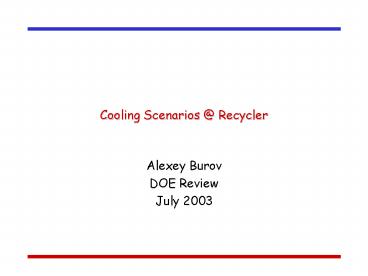Cooling Scenarios Recycler - PowerPoint PPT Presentation
1 / 18
Title:
Cooling Scenarios Recycler
Description:
Both electron cooling (EC) and stochastic cooling (SC) are supposed to do the job. ... There is no Landau damping up to frequencies ... – PowerPoint PPT presentation
Number of Views:76
Avg rating:3.0/5.0
Title: Cooling Scenarios Recycler
1
Cooling Scenarios _at_ Recycler
- Alexey Burov
- DOE Review
- July 2003
2
Introduction
- Recycler 3 km, 8.9 GeV/c, 40 p mm mrad ring for
cooling and stacking of pbars from the
Accumulator. - The goal is to stack (2-6)E12 pbars inside
(100-30) eVs and (10-7) p mm mrad with flux
(20-45)E10 pbars/hr (tougher numbers electron
cooling goal). - Both electron cooling (EC) and stochastic
cooling (SC) are supposed to do the job. - Requires
- Good vacuum
- Good MI shielding
- Suppression of longitudinal IBS diffusion
3
Stochastic Cooling Only
- Before EC gets functioning, what can be done with
SC only? - SC (0.5-1)?(1-2) GHz for 2-4 GHz for ?.
- Scenario
- batches arrive from Accumulator every 3-4 hours
- stacked longitudinally inside 100 eVs and
cooled transversely against gas diffusion to be
inside 10 p µm - IBS-driven longitudinal emittance growth is
suppressed with proper bunching. - Modeling
- Longitudinal Fokker-Planck equation where both
friction and diffusion include SC and IBS terms. - Transverse SC gas diffusion equilibrium
4
Stochastic Cooling Only Results
- Losses longitudinal (efficiency of coalescing in
MI is a function of the initial phase space) and
transverse (finite lifetime due to gas
scattering). - Results
- For as good vacuum as 4 µm/hr (eff. pressure only
2x of Accumulator), and lt10 of total phase space
dilution, MI can get 2E12 pbars in 36?3 eVs. - For 8 µm/hr, MI gets 1.4E12 pbars
- Conclusion
- With SC only (no EC), benefits of Recycler
integration are marginal.
5
Longitudinal Distribution
- Longitudinal evolution after the last injection
(SC-IBS equilibrium). - Black before the injection, red just after,
all other changes after every ¾ hour. The number
of particles 3E12, the total time is 3 hours.
6
Efficiency of Coalescing in MI
Efficiency of coalescing, , as a function of
the initial phase space area (by I. Kourbanis).
7
S-Cooling, Gas Heating and Lifetime
dependence of the lifetime on the beam emittance
(by V. Lebedev)
8
E-Cool Tools Goals
9
Cooling Process
- Every repetition interval, a new pbar batch is
injected in RR. - The batch can be either kept separated from the
accumulated stack for one more repetition
interval, or immediately merged with the stack. - A reason for separation is batch transverse
stochastic pre-cooling (BSC), which would make
the following EC more effective. To make BSC
faster, the batch phase space can be deliberately
inflated. The goal for BSC is to make batch and
stack emittances equal. - EC may be off for the batch.
- After BSC, the batch is merged with the stack,
and a new batch is injected on its place. - The stack is both e-cooled and s-cooled (?,
gated, for tail pbars). - The stack is properly compressed , to suppress
longitudinal IBS emittance growth (? IBS is weak
for RR). - After the merger, the stack phase space is
increased by the batch. EC has to cool it down to
design value (30 eVs) for rep. time (1 hr). - Transverse EC acts against gas diffusion.
- To prevent core over-cooling, e-beam can be
deliberately misalign.
10
Cooling Simulations
- The whole process is modeled by Monte-Carlo
simulations. - SC cooling diffusion.
- EC cooling rates are functions of 3 pbar actions
for given e-beam parameters (current?length,
radius, effective temperature). - EC rates have been analytically calculated by
averaging of the friction power over pbar phases
and e-beam angle distribution, assuming it
Gaussian (5D integrals). - Two-stage simulation 1. BSC and 2. after-merger
ECSC - IBS diffusion can be neglected for proper
compression (checked by Bjorken-Mtingwa
formulae). - Several scenarios are presented to show a space
of possibilities.
11
IBS
- (Phase space diffusion) ? (bunching)2 x
(momentum diffusion). - With more compression, IBS diffusion goes down
due to - bunching2
- vz/vx gets closer to equilibrium (Fig. below with
red as direct B-M calculation).
12
Small emittance, nominal e-current
13
Small emittance vacuum for e-current
14
Nominal emittance, nominal e-current
15
Nominal emittance vacuum for e-current
16
Space Charge and Coherent Instabilities
- The space charge tune shift for max number of
stacked pbars, small emittance scenario is as
high as 0.08, which is not far from the
conventional limit 0.10-0.15 . - There is no Landau damping up to frequencies
- Thus, a broadband feedback up to SC lower
frequency is required. - Growth time due to resistive wall is calculated
as 300 turns at lowest frequency.
17
Conclusions
- Pbar stacking goals require to be inside a
certain volume in the space of parameters
(vacuum, e-current, e-angles, s-cool, acceptance,
). - For moderately good vacuum
- eff pressure 4x AA ? pencil beam lifetime
200 hr - and good alignment
- rms e-angle (1D) 0.2 mrad
- e-current 0.5 A is sufficient.
- For better vacuum, current requirements are
reduced. - The stack bunching varies during cooling.
E-current may be either DC or pulse with the same
pattern. - For the same e-current, e-angles and vacuum, the
stack emittance can be as any value between 3 and
10 mm mrad. - Discussions with D. McGinnis and V. Lebedev were
essential for this work.
18
(No Transcript)































